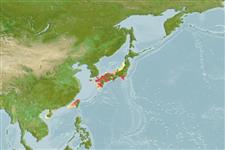>
Blenniiformes (Blennies) >
Blenniidae (Combtooth blennies) > Salariinae
Etymology: Cirripectes: Latin, cirrus = curl fringe + Greek, pektos, -e, -on = made of several parts solidly united (Ref. 45335); kuwamurai: Named for Dr. Tetsuo Kuwamura, collector of the only known specimen..
Environment: milieu / climate zone / depth range / distribution range
Ecología
marino demersal; rango de profundidad 0 - 5 m. Temperate
Distribución
Países | Áreas FAO | Ecosistemas | Ocurrencias, apariciones | Point map | Introducciones | Faunafri
Northwest Pacific: Shirahama, Wakayama Prefecture, Japan.
Tamaño / Peso / Age
Maturity: Lm ? range ? - ? cm
Max length : 5.6 cm SL macho / no sexado; (Ref. 635)
Espinas dorsales (total) : 12; Radios blandos dorsales (total) : 16; Espinas anales: 2; Radios blandos anales: 17; Vértebra: 32. Diagnosis: Dorsal fin XII, 16, membrane attached to caudal fin, with deep notch above last spine, first spine almost same or slightly higher than second; anal fin II, 17; pectoral rays 15; pelvic fin I, 4; caudal fin rays 13, procurrent rays 10, branched 9. Vertebrae 10 + 22. LL, without scales and scalelike flaps; LL tubes 2-11 (usually 5-9), canal ends below posterior to 7th dorsal ray. Upper lip crenulae 41. Gill rakers 23. Cephalic sensory pore complex. Cirri, nuchal 30, supraorbital 13, nasal 10; ventralmost nuchal cirri borne on greatly enlarged nuchal flap; cirri above flaps have no membranous ridge connection at their bases. Overall brown, head with scarlet reticulations, body with 5 scarlet stripes; dorsal fin with red spots and distal margin (Ref. 529, 635).
Facultative air-breathing in the genus (Ref. 126274); Found in a moderately exposed rocky reef about 3 m deep (Ref. 635). Oviparous. Eggs are demersal and adhesive (Ref. 205), and are attached to the substrate via a filamentous, adhesive pad or pedestal (Ref. 94114). Larvae are planktonic, often found in shallow, coastal waters (Ref. 94114).
Life cycle and mating behavior
Maturities | Reproducción | Spawnings | Egg(s) | Fecundities | Larva
Oviparous, distinct pairing (Ref. 205).
Williams, J.T., 1988. Revision and phylogenetic relationships of the blenniid fish genus Cirripectes. Indo-Pac. Fish. (17):78 p. (Ref. 529)
IUCN Red List Status (Ref. 130435)
Threat to humans
Harmless
Human uses
Pesquerías: sin interés
Herramientas
Special reports
Download XML
Fuentes de Internet
Estimates based on models
Phylogenetic diversity index (Ref.
82804): PD
50 = 0.5000 [Uniqueness, from 0.5 = low to 2.0 = high].
Bayesian length-weight: a=0.01072 (0.00480 - 0.02393), b=3.01 (2.82 - 3.20), in cm total length, based on LWR estimates for this (Sub)family-body shape (Ref.
93245).
Nivel trófico (Ref.
69278): 2.0 ±0.00 se; based on food items.
Resiliencia (Ref.
120179): Alto, población duplicada en un tiempo mínimo inferior a 15 meses (Preliminary K or Fecundity.).
Fishing Vulnerability (Ref.
59153): Low vulnerability (10 of 100).
